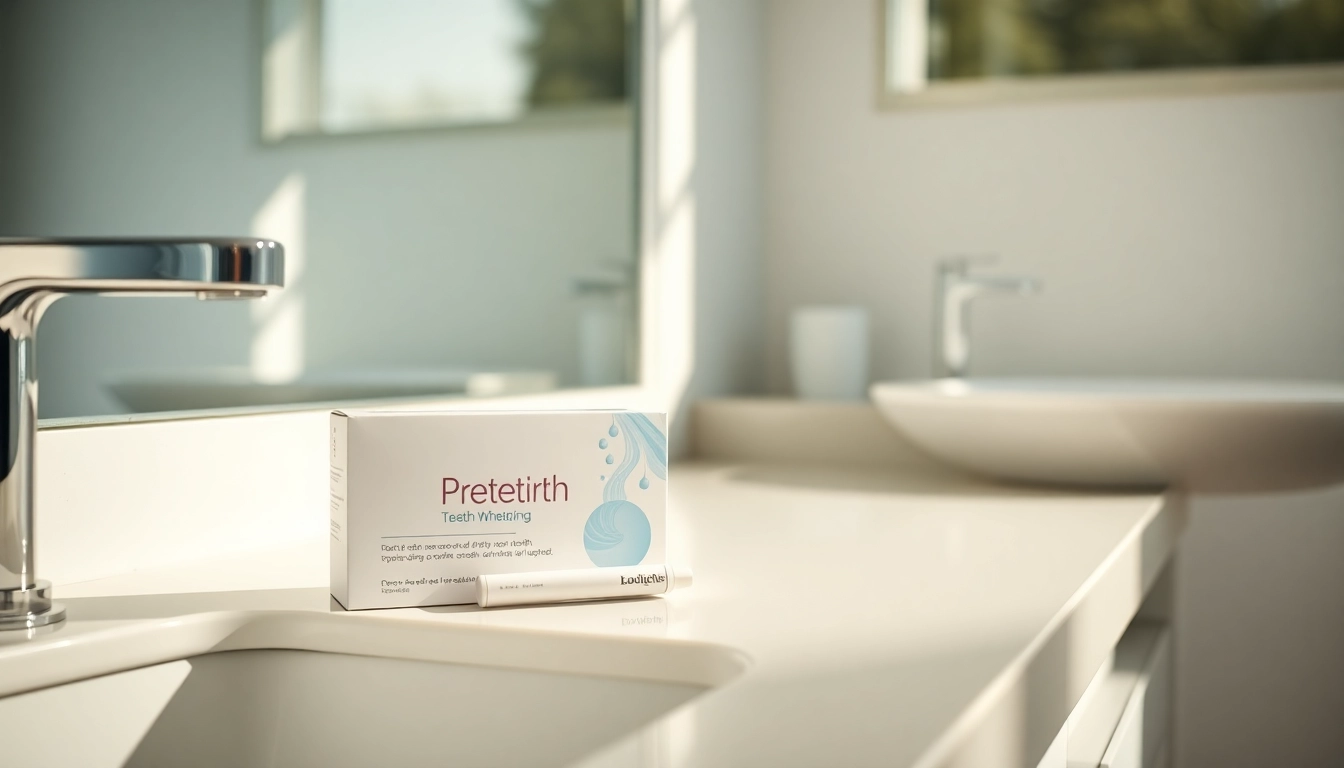Understanding Teeth Whitening Kits
What are Teeth Whitening Kits?
Teeth whitening kits have gained significant popularity in recent years as more individuals seek an effective solution to enhance their smile. These kits are products available for home use, designed to lighten the color of teeth and remove stains that accumulate over time from food, beverages, and other lifestyle factors. Typically, a teeth whitening kit includes a bleaching agent, usually hydrogen peroxide or carbamide peroxide, along with various components such as trays, strips, and LED accelerators, depending on the specific product.
How Do They Work?
The underlying principle of teeth whitening kits revolves around the use of bleaching agents that penetrate the enamel and dentin to break down stains. When applied to the teeth, these agents unleash oxygen molecules that target and eliminate discoloration. Typically, the whitening process may take from a few days to several weeks, depending on the concentration of the bleaching agent and the individual’s teeth condition. The application also varies; some kits utilize pre-filled trays, others require custom tray molds, while some opt for toothpaste or whitening strips.
Benefits and Risks Involved
Utilizing a teeth whitening kit presents several benefits, including enhanced aesthetic appeal, increased self-esteem, and improved oral hygiene awareness among users. Users often appreciate the convenience and cost-effectiveness of home whitening solutions compared to professional treatments, which tend to be more expensive and time-consuming. However, risks exist, such as potential tooth sensitivity, gum irritation, and overuse that can lead to enamel erosion. Hence, understanding personal dental health and following the manufacturer’s guidelines is crucial for the safe use of these products.
Types of Teeth Whitening Kits Available
Understanding Different Whitening Systems
Teeth whitening kits fall into various categories, each with a unique mechanism and effectiveness. Home whitening kits typically include:
- Whitening Strips: Thin plastic strips coated with a peroxide-based whitening gel. Usually, they are placed on the teeth for a set duration.
- Gel and Tray Kits: Contain a whitening gel and a custom or generic tray. The user fills the tray with gel and wears it for a prescribed period.
- Whitening Toothpaste: Contains mild abrasives and chemicals that help lift surface stains but produce minimal results compared to other methods.
- LED Light Devices: These utilize a combination of gel and LED light to enhance the whitening process, purportedly speeding it up by activating the whitening agents.
Comparing Home Kits vs. Professional Treatments
When deciding between home whitening kits and professional treatments, several factors come into play. Home kits offer convenience and affordability, making them accessible for many consumers. However, they may not provide the same level of results as professional treatments, which utilize stronger concentrations of whitening agents, and usually involve a dentist who can cater the treatment to specific teeth conditions. Professional treatments can also mitigate risks of sensitivity, as dentists have experience managing side effects. Nevertheless, home kits have improved significantly and in some cases can yield comparable results with sustained use.
Choosing the Right Product for Your Needs
Selecting the appropriate teeth whitening kit depends on several personal factors, including the degree of discoloration, sensitivity levels, budget, and time commitment. Users with severe stains might benefit more from professional treatments or advanced home systems with higher peroxide concentrations. For individuals looking for mild whitening or maintenance, over-the-counter options could suffice. Reading product reviews and consulting with a dental professional can also guide effective decisions tailored to individual requirements.
How to Use a Teeth Whitening Kit Effectively
Step-by-Step Instructions for Best Results
To maximize the effectiveness of a teeth whitening kit, following the manufacturer’s instructions is essential. Generally, here are the steps to consider:
- Brush and Floss: Before starting, ensure your teeth are clean. This enables the whitening agent to directly contact the teeth.
- Prepare the Kit: If using a gel and tray system, ensure the tray fits your teeth properly. Customize it as per the kit’s instructions if needed.
- Apply the Whitening Agent: Carefully apply the gel, avoiding excess on the gum line to prevent irritation. If using strips, align them properly with the teeth.
- Wear as Directed: Follow the recommended wear time diligently. Overuse can lead to adverse effects.
- Rinse and Maintain: After the recommended time, remove the tray or strips and rinse thoroughly. Follow up with a gentle toothpaste.
Common Mistakes to Avoid
Even with the best products, several common mistakes can undermine the teeth whitening process:
- Not Following Instructions: Skipping steps or failing to adhere to wear times can reduce effectiveness.
- Ignoring Dental Health: Whitening kits should not be used if you have untreated cavities or gum disease.
- Overusing the Product: Excessive application can lead to tooth sensitivity and enamel damage, countering the desired effect.
How Long Should You Use Your Kit?
The duration of use is highly contingent on the kit type and the initial tooth shade. Most over-the-counter kits suggest usage spanning from a few days to several weeks. It’s recommended to take breaks when sensitivity occurs or to consult with a dental professional for personalized advice. Typically, if needed, a second cycle of whitening can start after a few months, but allowance for enamel recovery should be considered.
Maintaining Your Bright Smile Post-Whitening
Best Practices for Oral Hygiene
Maintaining the results from whitening procedures requires diligent oral hygiene practices. Regular brushing with fluoride toothpaste and flossing should continue. Consider using an enamel-safe whitening toothpaste to prolong the bright appearance of your teeth. Regular visits to the dentist for cleanings and check-ups can ensure oral health and keep stains under control.
Foods and Beverages to Avoid
After bleaching, some foods and drinks can lead to staining, so it’s advisable to minimize the intake of:
- Dark Berries: Such as blueberries or blackberries that can leave pigments.
- Red Wine: Known for its high chromagen content that can stain teeth.
- Coffee and Tea: Both can lead to discoloration over time, especially if consumed in excess.
- Sodas and Colored Beverages: Sugary drinks that can stain and contribute to decay.
When to Consider Repeating the Process
Timing for repeating the whitening process can depend on personal taste and dietary habits. Many individuals find they can repeat a whitening process after six months to a year, while others may wait longer. Observing how teeth respond after initial treatment, in conjunction with a balanced diet and good oral hygiene, will help determine the right timing.
FAQs About Teeth Whitening Kits
How Safe Are Teeth Whitening Kits?
Teeth whitening kits, when used according to instructions, are generally safe for the majority of individuals. However, those with specific dental issues such as severe cavities or gum disease should consult with a dentist before use. Adverse effects such as sensitivity or gum irritation might occur, but they are often temporary and subside after discontinuation of use.
Do Teeth Whitening Kits Work for Everyone?
Teeth whitening kits can be effective for many, but results vary based on the type of stains present, the individual’s oral health, and adherence to the usage instructions. Intrinsic stains, which are more challenging to treat, may not show significant improvement with home kits. Consulting a dental professional is recommended, especially for those with deep colors or very sensitive teeth.
What to Do if You Experience Sensitivity?
If tooth sensitivity occurs during or after using a whitening kit, consider the following actions:
- Discontinue Use: Stop using the kit until sensitivity decreases.
- Use Sensitivity Toothpaste: Products designed for sensitive teeth can help alleviate discomfort.
- Consult with a Dentist: If sensitivity persists, it’s wise to seek professional advice to ensure there are no underlying issues.



